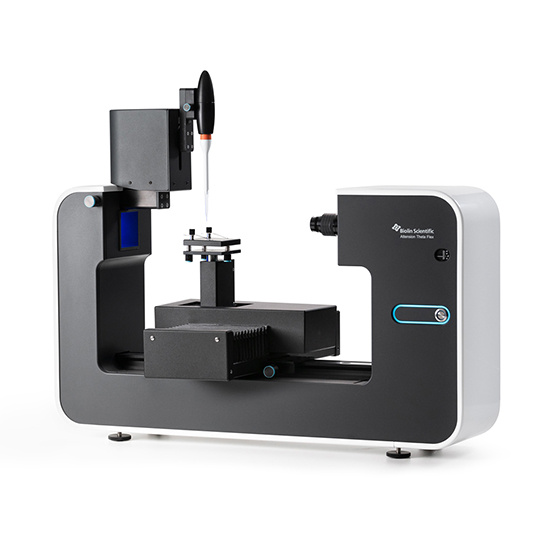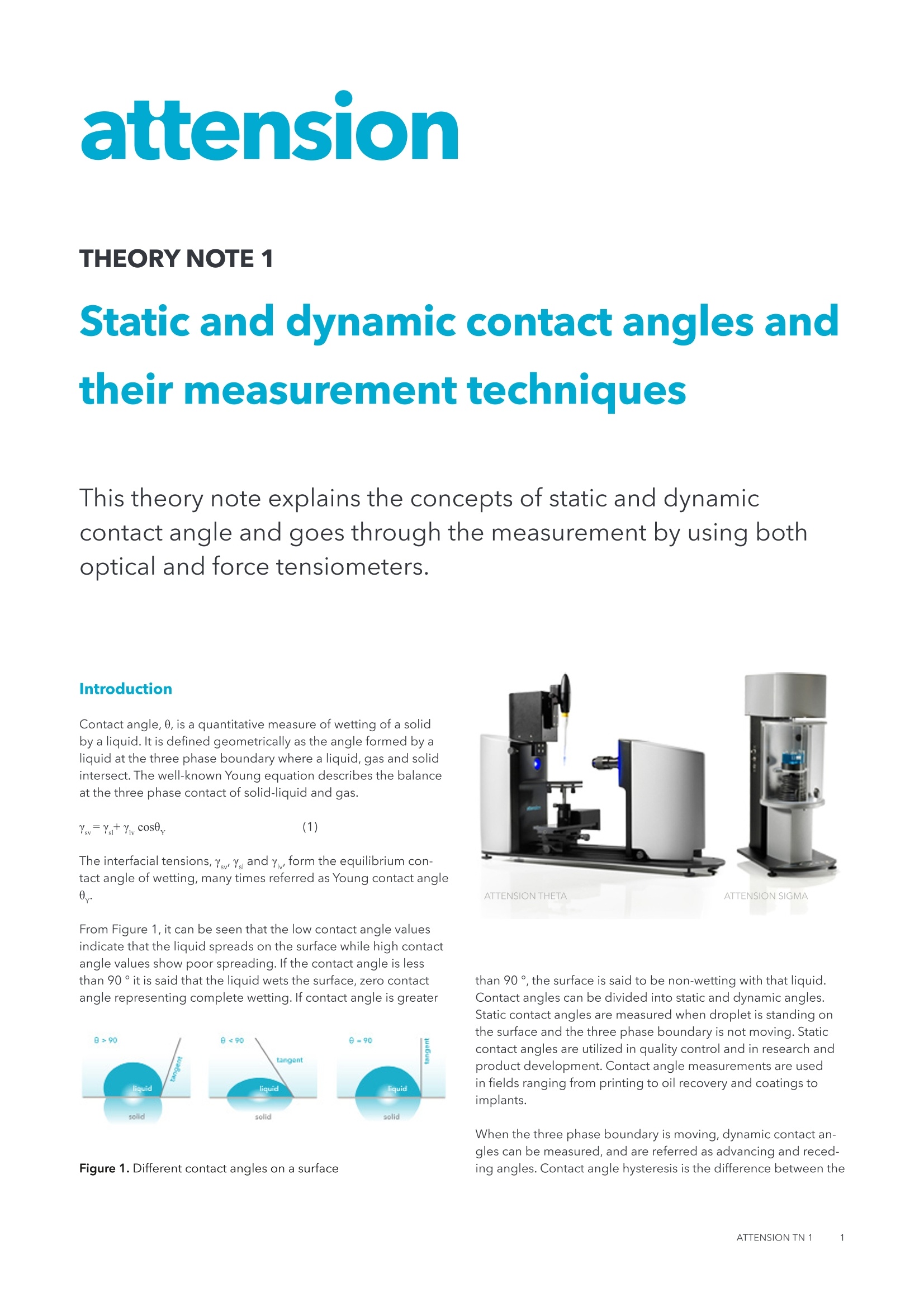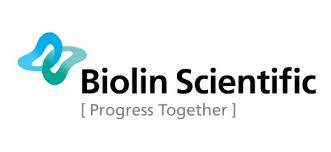
方案详情
文
本理论解释了动态和静态接触角的概念及其区别,并通过不同的测量方法:光学和力学接触角检测来分析评价两种接触角测量方法。
方案详情

attension THEORY NOTE 1 Static and dynamic contact angles andtheir measurement techniques This theory note explains the concepts of static and dynamiccontact angle and goes through the measurement by using bothoptical and force tensiometers. Introduction Contact angle, 0, is a quantitative measure of wetting of a solidby a liquid. It is defined geometrically as the angle formed by aliquid at the three phase boundary where a liquid, gas and solidintersect. The well-known Young equation describes the balanceat the three phase contact of solid-liquid and gas. The interfacial tensions,Yy. andy, form the equilibrium con-tact angle of wetting, many times referred as Young contact angle0.. From Figure 1, it can be seen that the low contact angle valuesindicate that the liquid spreads on the surface while high contactangle values show poor spreading. If the contact angle is lessthan 90 ° it is said that the liquid wets the surface, zero contactangle representing complete wetting. If contact angle is greater Figure 1. Different contact angles on a surface than 90 ° the surface is said to be non-wetting with that liquid.Contact angles can be divided into static and dynamic angles.Static contact angles are measured when droplet is standing onthe surface and the three phase boundary is not moving. Staticcontact angles are utilized in quality control and in research andproduct development. Contact angle measurements are usedin fields ranging from printing to oil recovery and coatings toimplants. When the three phase boundary is moving, dynamic contact an-gles can be measured, and are referred as advancing and reced-ing angles.Contact angle hysteresis is the difference between the advancing and receding contact angles. Contact angle hysteresisarises from the chemical and topographical heterogeneity of thesurface, solution impurities absorbing on the surface, or swelling,rearrangement or alteration of the surface by the solvent [1, 2].Advancing and receding contact angles give the maximum andminimum values the static contact angle can have on the surface.Difference between advancing and receding angles can be ashigh as 50°.Dynamic contact angles and contact angle hyster-esis has become a popular topic because of the recent interestin superhydrophobic and self-cleaning surfaces [3, 4]. This isimportant since small sliding angles (= angle the substrate hasto be tilted to move the droplet) are needed for self-cleaningapplications. Hysteresis is however also important in other situa-tions such as intrusion of water into porous media, coating, andadsorption at liquid/solid interface. Contact angle measurements by using opticaltensiometer Both static and dynamic contact angles can be measured byusing Theta optical tensiometer. In practice, a droplet is placedon the solid surface and the image of the drop is recorded. Staticcontact angle is then defined by fitting Young-Laplace equationaround the droplet, although other fitting methods such as circleand polynomial can also be used. Dynamic contact angles can be measured by using two differentapproaches; changing the volume of the droplet or by using tilt-ing cradle. Figure 2 (a) shows the principle of the volume chang-ing method. In short, a small droplet is first formed and placedon the surface. The needle is then brought close to the surfaceand the volume of the droplet is gradually increased whilerecording at the same time. This will give the advancing contactangle. The receding angle is measured the same way but thistime, the volume of the droplet is gradually decreased. In Figure2(b), the principle of the tilting cradle method is shown. Thedroplet is placed on the substrate which is then gradually tilted. Figure 2. Schematic of dynamic contact angle measurement byusing(a) volume changing method (b) tilting cradle. The advancing angle is measured at the front of the droplet justbefore the droplet starts to move. The receding contact angle ismeasured at the back of the droplet, at same time point. Contact angle measurements by using forcetensiometer Dynamic contact angles can be measured by using Sigma forcetensiometer. Force tensiometer measures the mass affecting tothe balance when a sample of solid is brought in contact with a test liquid. The contact angle can then be calculated by usingthe equation (2) when surface tension of the liquid (y) and theperimeter of the sample(P) are known. In Figure 3, a complete contact angle measurement cycle ispresented. As can be seen, with force tensiometer the measuredcontact angle is always dynamic contact angle since the sampleis moving against the liquid. When the sample is immerged tothe liquid the advancing contact angle is recorded and when thesample is emerging the receding contact angle is measured. Figure 3. Dynamic contact angle measurement by usingWilhelmy plate method. Comparison of the contact angle measurementtechniques Optical tensiometer is the main measurement method for contactangle since measurement of both static and dynamic contactangles is possible. It is also possible to study the homogeneityof the sample by measuring contact angle on several differ-ent places on the same sample. This is not possible with theWilhelmy plate method since the calculated contact angle is theaverage over the whole immersed area. For the same reason, inWilhelmy plate method the sample has to be homogenous onboth sides [5]. Contact angle measurements of special samples Although contact angle measurement is many times quitestraightforward, there are some special cases that require morecareful planning for the measurement set-up. These include fiber,samples that absorb the liquid and powders. Fibers Fibers and other thin objects can be measured by using opticaltensiometer equipped with picoliter dispenser or with forcetensiometer using Wilhelmy plate method. With optical tensiom-eter, the picoliter dispenser can produce droplets with the basediameter of about 30 to 50 um. With special optics and highspeed camera it is possible to take an image of this small dropletand the contact angle can be determined in a similar fashion thanby using microliter size droplets. Force tensiometer on the otherhand can be used by utilizing a special holder for the fiber. Dueto extremely small forces exerted to the balance, anti-vibrationtable and cabinet are required for reliable measurements. Both ofthese methods are reviewed more in details in application note 1. Many times contact angles are measured on the substrates thatabsorb the measuring liquid. In this case contact angles are typi-cally analyzed as a curves for further analyses. In case one valuesis needed, care must be taken that the contact angle is measured and reported repeatably. Most often the first contact angle valuemeasured is then taken as the contact angle result. Since theabsorption usually happens very quickly, high speed cameras areoften utilized. Powders Contact angles on powders can be measured by using sessiledrop measurement on the compressed powder tablet or byusing the force tensiometer with the Washburn method. Whencompressed tablets are measured, it can behave like the absorb-ing substrate if the powder is hydrophilic or the droplet canstay on the surface if the powder is hydrophobic. This and theWashburn method are explained in detail in theory note 5 andapplication note 7. References [1]A. Marmur,"Thermodynamic aspects of contact angle hyster-esis" Advances in Colloid and Interface Science 50 (1994) 121. [2]1. Gao and T.J. McCarthy,"Contact angle hysteresis explained""Langmuir 22 (2006)6234. [3] L. Feng, S. Li, Y. Li, H. Li, L.Zhang, J. Zhai, Y. Song, B. Liu, L. Jiang and D. Zhu, "Superhydrophobic surfaces: From natural toartificial",Advanced materials 14 (2002)1857. [4] R. Blossey, “Self-cleaning surfaces - virtual realities" NatureMaterials 2 (2003) 301. [5] L. M. Lander, L. M. Siewierski, W.J. Brittain and E.A. Vogler, "ASystematic comparison of contact angle methods, Langmuir 9(1993)2237. Contact information ATTENSION TN TTENSION TN
确定



还剩1页未读,是否继续阅读?
瑞典百欧林科技有限公司为您提供《动态和静态接触角中测量技术检测方案 》,该方案主要用于其他中测量技术检测,参考标准--,《动态和静态接触角中测量技术检测方案 》用到的仪器有Attension Theta Flex 光学接触角仪、Theta Lite 光学接触角仪、Theta QC 光学接触角仪
相关方案
更多
该厂商其他方案
更多











